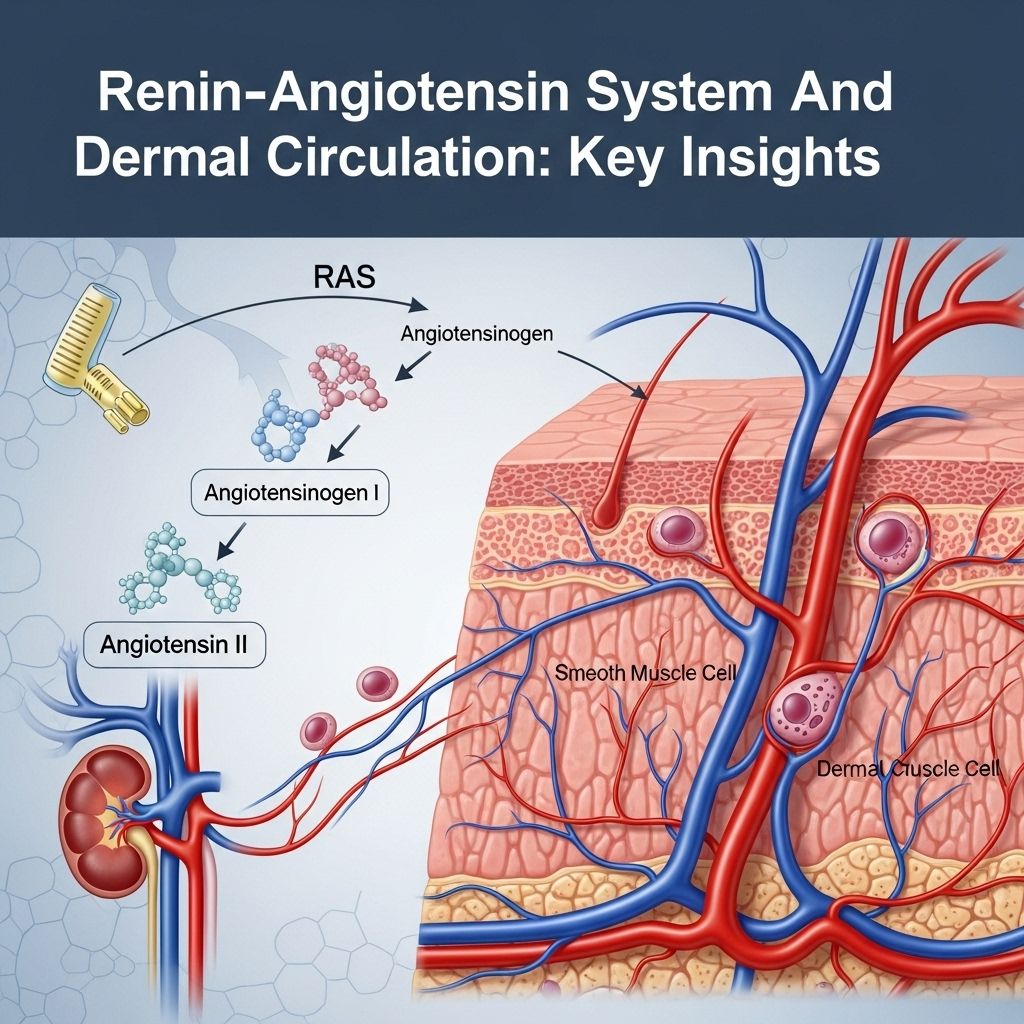Understanding Renin-Angiotensin System & Dermal Circulation
Hormonal signals in skin regulate vessel tone and inflammation to support healing.

Introduction to Renin-Angiotensin System (RAS)
The Renin-Angiotensin System (RAS) is a complex network of hormones and enzymes primarily known for its role in regulating blood pressure and fluid balance in the body. It is composed of several key components: renin, angiotensinogen, angiotensin-converting enzyme (ACE), angiotensin II (Ang-II), and angiotensin II receptors (AT1R and AT2R) . Beyond its cardiovascular effects, RAS also influences various physiological processes, including skin health and dermal circulation.
RAS in Skin Health and Wound Healing
RAS components are expressed in the skin, influencing processes such as skin development, homeostasis, and wound healing. Angiotensin II, a major effector of RAS, plays a crucial role in cell migration and proliferation, collagen metabolism, and inflammation, all of which are essential for wound healing . The expression of RAS components in the skin suggests that local RAS may have a significant impact on skin health, similar to its effects on other organs.
Role of Angiotensin II in Skin
Angiotensin II, particularly through its receptors AT1R and AT2R, affects skin physiology. AT1R promotes vasoconstriction, inflammation, and fibrosis, while AT2R is associated with vasodilation and anti-inflammatory effects . This balance between AT1R and AT2R activities can influence skin regeneration, fibrosis formation, and inflammation, highlighting the complex interplay of RAS in skin health.
Dermal Circulation and RAS
RAS also plays a role in dermal microcirculation, affecting how blood flows through the skin’s small blood vessels. Components of RAS, such as Ang-II and its receptors, influence vascular tone and response to local heating, which can be altered by RAS modulators like angiotensin receptor blockers (ARBs) . This regulation is crucial for maintaining proper skin microvascular function and responding to environmental changes.
Angiotensin II impacts skin microcirculation primarily through its action on AT1R, which can lead to vasoconstriction and reduced blood flow. This effect is counteracted by AT2R, which promotes vasodilation and improved circulation. The balance between these receptors can affect how the skin responds to environmental stimuli, such as heat, and how it adapts to conditions that require increased blood flow .
Physiological and Pathological Effects of RAS on Dermal Circulation
RAS components have both physiological and pathological effects on dermal circulation. Physiologically, they help regulate blood pressure and fluid balance necessary for maintaining healthy skin microcirculation. Pathologically, overactivation of certain RAS components, particularly AT1R, can lead to inflammation and fibrosis, potentially impairing skin function and healing processes .
Physiological Effects
- Regulation of Vascular Tone: RAS helps maintain the balance of blood vessel constriction and dilation, ensuring adequate blood flow to the skin.
- Adaptation to Environmental Changes: RAS influences how the skin responds to heat and cold, aiding in thermoregulation.
Pathological Effects
- Inflammation and Fibrosis: Overstimulation of AT1R can lead to increased inflammation and fibrosis, negatively impacting skin health and healing.
- Impaired Wound Healing: Dysregulation of RAS can hinder the wound healing process by affecting cell proliferation and tissue repair.
Role of RAS Modulators in Dermal Circulation
RAS modulators, such as ACE inhibitors and ARBs, can influence dermal circulation by altering the activity of RAS components. These drugs are primarily used to manage hypertension but also have implications for skin health by reducing inflammation and improving microvascular function .
ACE Inhibitors and ARBs
- ACE Inhibitors: These drugs block the conversion of angiotensin I to angiotensin II, reducing the vasoconstrictive effects of Ang-II and potentially improving skin circulation.
- ARBs: By blocking AT1R, ARBs reduce the effects of Ang-II on vasoconstriction and inflammation, which can enhance skin health and microvascular function.
Implications for Disease Management
Understanding the role of RAS in dermal circulation has significant implications for managing diseases related to skin health and microvascular dysfunction. Conditions such as hypertension, diabetes, and cardiovascular diseases can all impact skin circulation, and RAS modulators may offer therapeutic benefits by improving microvascular function and reducing pathological effects .
Frequently Asked Questions (FAQs)
Q: What is the primary role of the Renin-Angiotensin System (RAS) in the body?
A: The primary role of RAS is to regulate blood pressure and fluid balance by controlling the amount of fluid in the blood vessels.
Q: How does RAS affect skin health?
A: RAS influences skin health through its effects on cell migration, proliferation, collagen metabolism, inflammation, and fibrosis, all of which are crucial for wound healing and skin regeneration.
Q: What are the implications of RAS modulators for dermal circulation?
A: RAS modulators, such as ACE inhibitors and ARBs, can improve dermal circulation by reducing vasoconstriction and inflammation, potentially enhancing skin health and microvascular function.
Conclusion
In conclusion, the Renin-Angiotensin System plays a multifaceted role in dermal circulation and skin health. Through its influence on vascular tone, inflammation, and fibrosis, RAS affects not only blood pressure regulation but also skin microvascular function and overall health. Understanding these mechanisms is crucial for developing therapeutic strategies to manage conditions related to skin health and microvascular dysfunction.
References
- https://www.ajmb.org/Article?id=60580
- https://www.jpp.krakow.pl/journal/archive/06_19/articles/01_article.html
- https://www.ncbi.nlm.nih.gov/books/NBK470410/
- https://www.nature.com/articles/s41440-025-02329-2
- https://www.osmosis.org/learn/Renin-angiotensin-aldosterone_system
- https://cvphysiology.com/blood-pressure/bp015
- https://en.wikipedia.org/wiki/Renin%E2%80%93angiotensin_system
- https://www.youtube.com/watch?v=ibjodC7Ft7U
- https://onlinelibrary.wiley.com/doi/abs/10.1111/j.1600-0625.1995.tb00056.x
Read full bio of Sneha Tete












